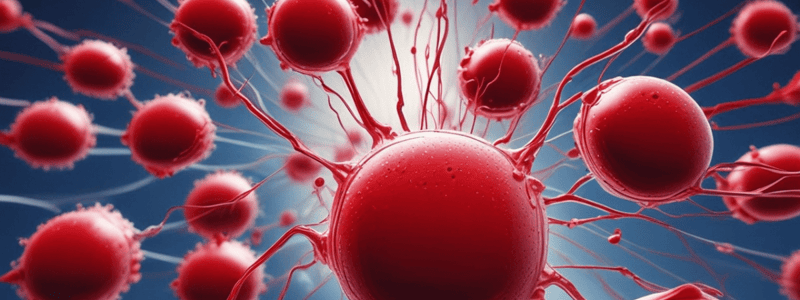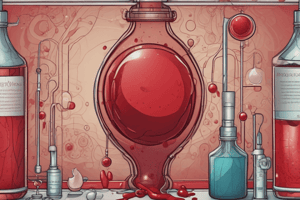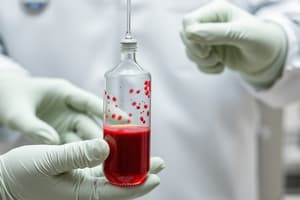Podcast
Questions and Answers
What is the primary purpose of red cell concentrates?
What is the primary purpose of red cell concentrates?
- To act as antibodies
- To separate cells from plasma (correct)
- To increase the number of platelets
- To provide clotting factors
Which component of blood is transfused mainly in severe cases of blood loss?
Which component of blood is transfused mainly in severe cases of blood loss?
- Cryoprecipitate
- Whole blood (correct)
- Immunoglobulins
- Platelet concentrates
What is the key function of Immunoglobulins in the body?
What is the key function of Immunoglobulins in the body?
- To provide extra clotting factors
- To act as antigens
- To act as antibodies (correct)
- To increase red blood cells count
How is Cryoprecipitate obtained?
How is Cryoprecipitate obtained?
Which component of blood can be given to patients needing extra clotting factors?
Which component of blood can be given to patients needing extra clotting factors?
What type of blood can recipients of Blood group A and AB receive according to the table?
What type of blood can recipients of Blood group A and AB receive according to the table?
Which group of proteins contains many substances needed for blood clotting?
Which group of proteins contains many substances needed for blood clotting?
Which part of the blood is made by centrifuging whole blood?
Which part of the blood is made by centrifuging whole blood?
Which of the following antibodies would be present in an individual with B-positive blood?
Which of the following antibodies would be present in an individual with B-positive blood?
What is the process by which antibodies cause red blood cells to clump together?
What is the process by which antibodies cause red blood cells to clump together?
Which of the following blood components is most commonly transfused?
Which of the following blood components is most commonly transfused?
What is the age range for potential blood donors in Australia, according to the information provided?
What is the age range for potential blood donors in Australia, according to the information provided?
Which of the following statements is correct regarding blood donation in Australia?
Which of the following statements is correct regarding blood donation in Australia?
Which of the following blood types would be able to receive blood from a donor with AB-positive blood?
Which of the following blood types would be able to receive blood from a donor with AB-positive blood?
What is the primary function of the circulatory system mentioned in the text?
What is the primary function of the circulatory system mentioned in the text?
According to the information provided, what is the age range for which parental permission may be required for blood donation in some states?
According to the information provided, what is the age range for which parental permission may be required for blood donation in some states?
What are the molecules called that trigger an immune response?
What are the molecules called that trigger an immune response?
Which of the following best describes the ABO blood group system?
Which of the following best describes the ABO blood group system?
If an individual has both antigen A and antigen B on their red blood cells, what is their ABO blood group?
If an individual has both antigen A and antigen B on their red blood cells, what is their ABO blood group?
What is the ABO blood group of an individual who has neither antigen A nor antigen B on their red blood cells?
What is the ABO blood group of an individual who has neither antigen A nor antigen B on their red blood cells?
Which of the following statements is true regarding the inheritance of ABO blood groups?
Which of the following statements is true regarding the inheritance of ABO blood groups?
What is formed when an antigen and its corresponding antibody combine?
What is formed when an antigen and its corresponding antibody combine?
Which of the following statements is correct regarding the ABO blood group system?
Which of the following statements is correct regarding the ABO blood group system?
What is the role of antibodies in the ABO blood group system?
What is the role of antibodies in the ABO blood group system?
What is the main purpose of the circulatory system according to the passage?
What is the main purpose of the circulatory system according to the passage?
What happens when Rh-negative blood is exposed to Rh-positive blood for the first time?
What happens when Rh-negative blood is exposed to Rh-positive blood for the first time?
What is the main difference between whole blood and red cell concentrates?
What is the main difference between whole blood and red cell concentrates?
What is the main purpose of matching Rh blood groups for transfusions?
What is the main purpose of matching Rh blood groups for transfusions?
What is the main purpose of using red cell concentrates for transfusions?
What is the main purpose of using red cell concentrates for transfusions?
What is the main reason for adding a chemical to whole blood during a transfusion?
What is the main reason for adding a chemical to whole blood during a transfusion?
What is the main difference between ABO and Rh blood group incompatibility?
What is the main difference between ABO and Rh blood group incompatibility?
What is the main reason for removing platelets and white blood cells from red cell concentrates?
What is the main reason for removing platelets and white blood cells from red cell concentrates?
What is the primary function of the septum in the heart?
What is the primary function of the septum in the heart?
If the heart rate is 58 beats per minute and 70 ml of blood is expelled with each beat, what is the cardiac output in liters per minute?
If the heart rate is 58 beats per minute and 70 ml of blood is expelled with each beat, what is the cardiac output in liters per minute?
Which of the following statements accurately describes the difference between systole and diastole?
Which of the following statements accurately describes the difference between systole and diastole?
What is the primary reason for the failure of early attempts at blood transfusions between humans?
What is the primary reason for the failure of early attempts at blood transfusions between humans?
Which scientist is credited with the discovery of the ABO blood group system?
Which scientist is credited with the discovery of the ABO blood group system?
What is the primary function of the molecules on the surface of red blood cells?
What is the primary function of the molecules on the surface of red blood cells?
Which of the following statements about blood transfusions is accurate?
Which of the following statements about blood transfusions is accurate?
What is the purpose of the Rh blood group system, discovered by Karl Landsteiner in 1940?
What is the purpose of the Rh blood group system, discovered by Karl Landsteiner in 1940?
list four reasons why someone would require a transfusion
list four reasons why someone would require a transfusion
3 Describe the process of agglutination.
3 Describe the process of agglutination.
2 List the antibodies that would be present or produced from someone with B-negative blood.
2 List the antibodies that would be present or produced from someone with B-negative blood.
8 Explain why patients with severe bleeding receive plasma transfusions.
8 Explain why patients with severe bleeding receive plasma transfusions.
7 Compare and contrast the ABO blood groups and the Rh blood groups.
7 Compare and contrast the ABO blood groups and the Rh blood groups.
Flashcards
Red cell concentrates purpose
Red cell concentrates purpose
To separate red blood cells from other blood components (plasma).
Blood component in severe blood loss
Blood component in severe blood loss
Whole blood, containing all components.
Immunoglobulin function
Immunoglobulin function
They act as antibodies, fighting off infections.
Cryoprecipitate origin
Cryoprecipitate origin
Signup and view all the flashcards
Blood component for clotting factors
Blood component for clotting factors
Signup and view all the flashcards
Blood type for A & AB recipients
Blood type for A & AB recipients
Signup and view all the flashcards
Blood clotting protein group
Blood clotting protein group
Signup and view all the flashcards
Red cell concentrates creation
Red cell concentrates creation
Signup and view all the flashcards
B-positive blood antibody
B-positive blood antibody
Signup and view all the flashcards
Agglutination definition
Agglutination definition
Signup and view all the flashcards
Most transfused blood component
Most transfused blood component
Signup and view all the flashcards
Australian blood donor age range
Australian blood donor age range
Signup and view all the flashcards
Australian blood donation payment laws
Australian blood donation payment laws
Signup and view all the flashcards
Blood types receiving AB-positive
Blood types receiving AB-positive
Signup and view all the flashcards
Circulatory system primary function
Circulatory system primary function
Signup and view all the flashcards
Parental permission blood donation age
Parental permission blood donation age
Signup and view all the flashcards
Immune response triggers
Immune response triggers
Signup and view all the flashcards
ABO blood group system base
ABO blood group system base
Signup and view all the flashcards
ABO blood group with A&B antigens
ABO blood group with A&B antigens
Signup and view all the flashcards
ABO blood group with neither A nor B
ABO blood group with neither A nor B
Signup and view all the flashcards
ABO blood group inheritance
ABO blood group inheritance
Signup and view all the flashcards
Antigen-antibody combination
Antigen-antibody combination
Signup and view all the flashcards
ABO blood group possibilities
ABO blood group possibilities
Signup and view all the flashcards
Antibody role in ABO
Antibody role in ABO
Signup and view all the flashcards
Study Notes
Blood and Blood Products
- Red cell concentrates are the most widely used component of blood, made by centrifuging whole blood to separate cells from plasma.
- Platelet concentrates are given to patients with abnormal platelets or a reduced number of platelets.
- Immunoglobulins are a group of proteins that act as antibodies, extracted from plasma of suitable donors.
- Cryoprecipitate is obtained by freezing and thawing plasma, containing many substances needed for blood clotting.
- Plasma is the liquid part of blood, given to patients needing extra clotting factors or with severe liver disease.
ABO Blood Groups and Donor-Recipient Matching
- Antigens A and B are on the surface of red blood cells, and antibodies are produced in response.
- ABO blood groups are determined by the presence or absence of antigens A and B: A (A antigen), B (B antigen), AB (both), and O (neither).
- Donor-recipient matching is necessary to prevent agglutination reactions.
Blood Transfusions
- Whole blood is used mainly in cases of severe blood loss.
- Red cell concentrates are used for patients suffering from heart disease or severe anaemia.
- Blood transfusions can be given to patients with excessive blood loss, some types of anaemia, leukaemia, haemophilia, or other conditions.
Blood Typing
- The ABO blood group system was discovered by Karl Landsteiner in 1901.
- The Rh blood group system was discovered by Landsteiner in 1940.
- Blood groups are determined by the presence or absence of antigens on red blood cells.
- Incompatible blood transfusions can cause agglutination reactions.
Becoming a Blood Donor
- In Australia, blood is collected by the Red Cross Blood Transfusion Service and is free.
- Most states and territories in Australia prohibit payment for blood donations or charges for blood supplied to patients.
- Healthy people aged 16-70 can be potential donors, although in some states 16- and 17-year-olds may require parental permission.
Studying That Suits You
Use AI to generate personalized quizzes and flashcards to suit your learning preferences.



